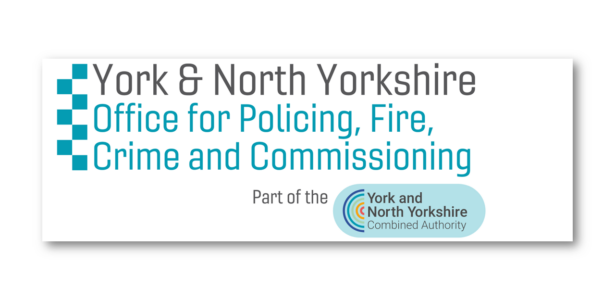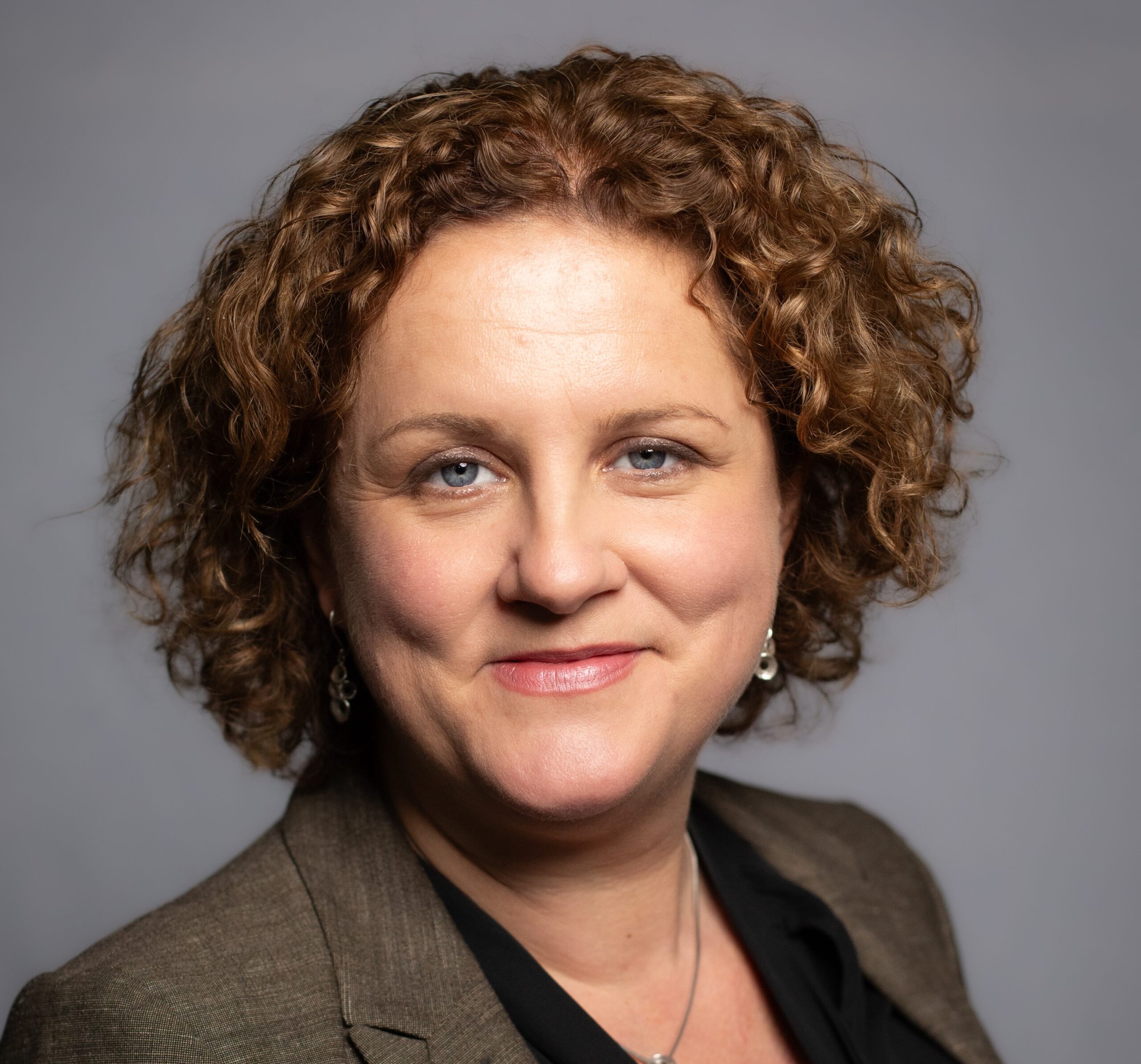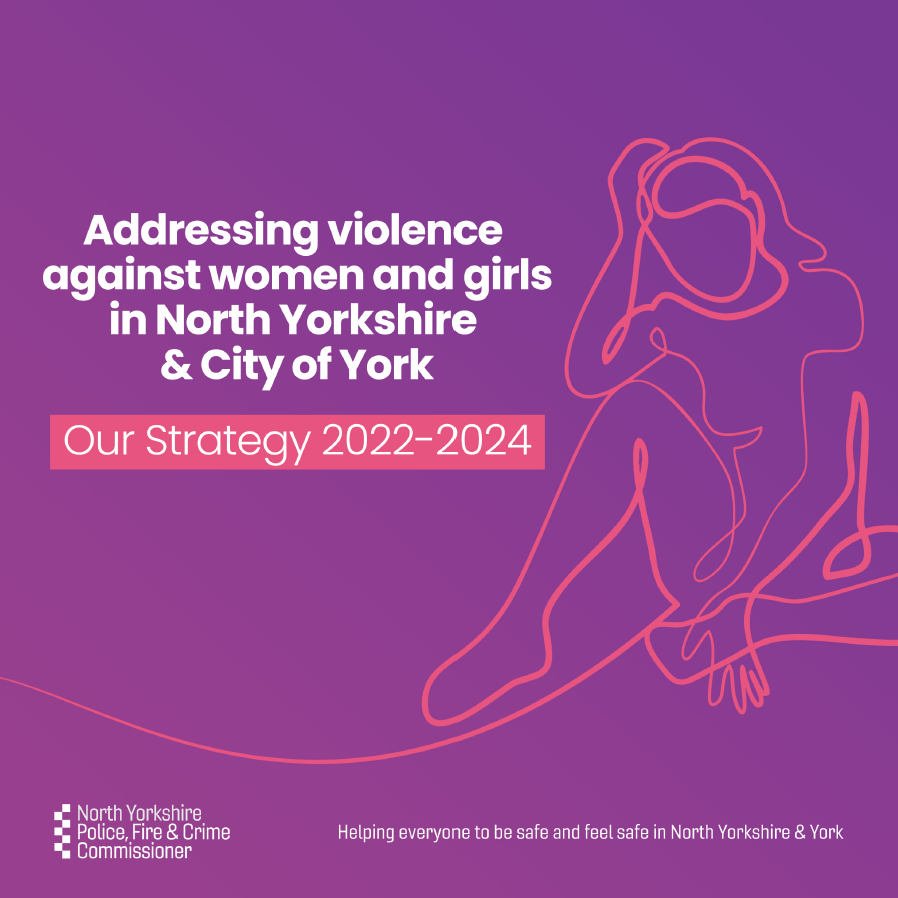Our Strategy

On this page
- Foreword
- Introduction
- Our Vision
- Our Approach
- Turning Strategy into Practice
- Acknowledgements
- Our Strategic Objectives
- Objective 1: Listening to All Women and Girls, including those from rural and under-represented communities, and proactively seeking feedback to inform continuous service improvements
- Objective 2: Tackling the root causes of VAWG through Prevention and Early Intervention
- Objective 3: Increasing Public Confidence and Trust in the Police
- Objective 4: Strengthening the Multi-Agency Approach to Address VAWG
- Objective 5: Enhancing Support Services for Victims
- Objective 6: Facilitating Behaviour Change by Perpetrators
- References:
- Download
Foreword
North Yorkshire Police, Fire & Crime Commissioner Zoë Metcalfe
Everyone across North Yorkshire and City of York should feel they are safe wherever they are, whatever they are doing and whenever that is. But, in too many cases, women and girls do not. I need to change that.
This new Strategy aims to identify the challenges and crucially, how police, fire and our community partners, alongside my office, work together to address them. Keeping women and girls safe – and ensuring they feel safe – is not something that one organisation, group or emergency service can deliver on their own. It is only by coming together, being honest about the problems and creative in finding solutions that will create the real change needed.
For me, this is personal. Like many women and girls I have been out at night and worried what was around that dark corner, I have felt the rising panic of not knowing who the footsteps behind me on the street belong to, and I have felt anger at being told that this is not really a problem by those who will never experience it. There are too many women facing violence in their homes, on our streets and in their communities and these issues are not the responsibility of women and girls to solve. That never has been the case, and it never will be.
Together, everyone must drive societal change. North Yorkshire and City of York is, statistically speaking, a safe place. But we should never forget that numbers in a spreadsheet do not tell the full story. There are still too many victims – women and girls who need to have their voices heard, who need to be confident there is a justice system that will believe them, and a network of help that supports them, builds their confidence and helps them rebuild their lives.
Words are easy, actions are not. We have already made progress but there is much more to do, and I hope this Strategy can be the catalyst for that. I have identified six strategic objectives which aim to create tangible change and make women and girls feel safe and be safe.
We will, alongside our police, fire and community partners:
- Ensure all women and girls are listened to, including those from under-represented communities
- Tackle the root causes of violence against women and girls with prevention and early intervention
- Increase public confidence and trust in North Yorkshire Police
- Strengthen partnerships so we work together, across agencies, to address the challenges
- Enhance the support available for victims and survivors
- Invest in early intervention to identify and stop potential offenders and change behaviour of those who have already offended to prevent re-offending.
Please judge us against these objectives. I want to ensure we reach a place where there is no need for a distinct strategy to tackle violence against women and girls but unfortunately, currently there is. We must change that, and we will – together.
This overarching Strategy for North Yorkshire and City of York encompasses North Yorkshire Police’s operational strategy on Violence Against Women and Girls, which was released in March 2022. You can read this here: Helping women and girls to feel safe and be safe | North Yorkshire Police.
I will continue to hold the force to account against this operational strategy and hope to see more being done to help women and girls to feel safe and be safe in our county.
Introduction
This Strategy sets out our collective commitment to tackle violence against women and girls across different settings, communities and locations throughout North Yorkshire and City of York.
Violence Against Women and Girls (“VAWG”) refers to any act of violence or abuse that disproportionately affects women or girls and is usually perpetrated by men; however we recognise that men and boys can also be victims of these crimes and women can be perpetrators. Although we will use the term ‘VAWG’ throughout this Strategy, unless otherwise stated, support and services are available for all victims of these crimes regardless of gender, age, sexuality or background.
Please see Appendix A for a full list and definitions of the VAWG types and abusive behaviours included within the scope of this Strategy – in brief these include:
- Misogyny and Street Harassment
- Domestic Abuse
- Rape and Sexual Offences
- Child Sexual Abuse and Exploitation
- Adult Sexual Exploitation
- Online Sexual Offending
- Illegal Cultural Harms
- Stalking and Harassment
- Breaches of Protective Orders
This Strategy has been informed by several national strategies, statutory guidance and academic research, including the National Violence Against Women and Girls’ strategy[1] and HMICFRS’ Final Inspection on the Police Response to Violence Against Women and Girls[2].
Consultation has taken place with local organisations representing women and girls and crucially with experts by experience by speaking directly to women and girls throughout North Yorkshire and City of York through focus groups and an on-line survey to ensure their voices remain central to the development and delivery of this Strategy. Please see Appendix B for a summary of the feedback and findings from this consultation.
Throughout this Strategy we will use the term ‘victim’ to describe those directly harmed by VAWG; language and terminology was something we specifically asked women and girls their views on and many agreed that this was the most recognisable and easily understood term. However, it is clear that individual experiences of VAWG are varied and often ‘fluid’. There is no one term which accurately reflects the experience of all those directly harmed by VAWG. Therefore for the purposes of this Strategy, the term ‘victim’ also includes survivors, those with lived experience and/or those who have been subjected to VAWG at any point during their lifetime.
Our Vision
By putting all women and girls at the centre of this Strategy, especially those that are under-represented and seldom heard, we aim to significantly enhance the services we already offer. We are creating an innovative and ambitious programme of work to address all forms of VAWG, ultimately making North Yorkshire and City of York one of the safest places in the country, particularly for women and girls.
Our Approach
We will continue to speak to women and girls about their individual experiences, and local organisations working with them, to measure progress against our Strategic Objectives and drive forward continuous service improvements. Please see Appendix D for a comprehensive list of all existing commissioned support services and interventions for victims and perpetrators of VAWG in North Yorkshire and City of York.
Whilst building on what we have already achieved to date, this Strategy will focus on identified gaps where work will be targeted to achieve meaningful and sustainable change at a local level to make a real difference to the lives of women and girls in North Yorkshire and City of York.
To realise our vision, VAWG needs to become everyone’s business including but not limited to:
- Education settings, including schools, colleges and universities
- Healthcare providers, including GP practices
- Social Care providers
- Housing providers, including private landlords
- Local Authorities
- Police and other emergency services
- Courts, including civil and family courts and legal professionals
- Prison and Probation services, including Parole Boards
- Voluntary and Community Organisations, including faith-based organisations and sports groups
- Banks and building societies
- Workplaces and local employers
- The Armed Services
Turning Strategy into Practice
This Strategy complements, and is complemented by, wider ongoing work and existing partnership arrangements. There are numerous examples of innovative partnership working and good practice already adopted within North Yorkshire and City of York to address specific types of VAWG (see Appendix C for further details).
We intend to continue to develop these successful approaches and utilise existing governance arrangements to extend best practice into other areas of VAWG wherever appropriate, working together to develop local delivery plans that will underpin this Strategy.
To facilitate this and monitor overall progress against our Strategic Objectives the VAWG Strategic Leadership Board will meet at least twice a year to conduct biannual reviews of progress against our local delivery plans.
This Board will include lay members and local organisations representing women and girls. The Board will publish the findings of these biannual progress reviews to provide greater transparency and accountability to increase public confidence in how we are improving the overall safety of women and girls.
The VAWG Strategic Leadership Board does not seek to duplicate or replace existing governance arrangements but aims to support partners in fulfilling their statutory responsibilities in respect of VAWG. Therefore, it is anticipated that existing partnerships including but not limited to the Community Safety Partnerships, Safeguarding Children’s Partnerships, Safeguarding Adults Boards and Local Criminal Justice Partnership will be represented on the Board to share details of relevant activity and escalate any issues or concerns so they can be resolved in a timely and consistent manner.
Acknowledgements
Thank you to the victims and survivors who imparted their expertise by experience with us in the focus groups, and everyone who took the time to respond to the online survey. The experiences that you all shared have informed this Strategy and will continue to shape and drive our local delivery plans.
Thank you to all the local organisations representing women and girls who took part in consultation workshops and provided valuable insight into local need to inform this Strategy and also helped us ensure we used a person-centred and trauma-informed approach wherever possible to seek feedback from with those that are at risk of and/or been subjected to VAWG: Changing Lives; Chessnuts; Humankind; IDAS; Kyra Women’s Project; Mountain Healthcare Ltd; New Beginnings; North Yorkshire Horizons; North Yorkshire Youth; PACE; Survive; The Children’s Society; The Halo Project; and York Women’s Counselling Service.
Thanks also to the strategic leads who have contributed to the development of this Strategy, representing our partners North Yorkshire Police; North Yorkshire Fire and Rescue Service; North Yorkshire County Council; City of York Council; Yorkshire and the Humber Probation Service; NHS North Yorkshire CCG; NHS Vale of York CCG; and TEWV NHS Foundation Trust.
Our Strategic Objectives
Objective 1: Listening to All Women and Girls, including those from rural and under-represented communities, and proactively seeking feedback to inform continuous service improvements
We will proactively engage with under-represented communities and seldom heard women, particularly:
- Ethnic Minority communities
- Girls in Care and Care Leavers
- Gypsy, Roma and Traveller communities
- LGBTQ+ community
- Armed Services communities
- Rural communities
- Sex Workers
- Students
- Those with Disabilities, including hidden disabilities and neurodiversity
We will also ensure parity of services across both urban and rural areas, to reflect unmet needs in these communities, with consideration of the unique vulnerabilities of those living in rural areas and other isolated communities.
Objective 2: Tackling the root causes of VAWG through Prevention and Early Intervention
Campaigns and Awareness Raising
Challenging everyday sexism and misogyny is key to tackling the root causes of VAWG, therefore we will develop a series of campaigns aimed at increasing awareness and promoting zero tolerance of all forms of gender inequality and VAWG. These will be developed and delivered across a number of settings but initially we will focus on:
- challenging misogyny from a young age, highlighting healthy vs unhealthy relationships and behaviours
- inappropriate language and behaviour, particularly street harassment
- Domestic Violence Disclosure Scheme, also known as ‘Clare’s law’
- spiking incidents, particularly within pubs and clubs
- sexual exploitation of adults, particularly increasing understanding of ‘survival sex’
- illegal cultural harms, clarifying that much of the conduct which sustains them is unlawful and/or criminal
- stalking in all its forms, including online harassment and ‘revenge porn’
Early Help and Community-led Interventions
We will develop and support a network of VAWG Champions in local communities and workplaces to help raise awareness of VAWG and ensure victims can more easily access help and advice at the earliest opportunity.
We will explore the development of ‘Safe Spaces’ and support other initiatives to keep women and girls safe in our city and town centres such as ‘Ask for Angela’ and vulnerability awareness training for workers in the night-time economy settings.
We will work with our local education partners to co-develop and co-produce age-appropriate materials to challenge misogyny from an early age.
Objective 3: Increasing Public Confidence and Trust in the Police
We will enable increased confidence in reporting VAWG crimes by enabling police officers to adopt a trauma aware response to ensure the right support is offered when victims do report.
This will be reinforced by ensuring the police take swift action when dealing with perpetrators by establishing early intervention opportunities and training the workforce to identify gateway VAWG offences.
We will continue to strengthen Rape and Domestic Abuse Scrutiny Panels to review cases which have not attained the required evidential level for prosecution or otherwise resulted in a failed prosecution, in order to identify learning opportunities and ensure continuous service improvements.
Objective 4: Strengthening the Multi-Agency Approach to Address VAWG
Safeguarding and Risk Management
We will support the expansion of multi-agency work focussed on identifying and supporting victims of all forms of VAWG and continue to develop the multi-agency partnership model to safeguard those involved in sex work, survival sex or at risk of sexual exploitation.
We will continue to support and develop the Multi-Agency Tasking And Coordination (“MATAC”) process to more effectively identify and target the most harmful and serial perpetrators of domestic abuse.
We will develop and enhance multi-agency responses to all forms of stalking and illegal cultural harms. We will also specifically target the perpetrators of trafficking and sexual exploitation offences through the national anti-trafficking and anti-slavery network.
Criminal Justice Processes
We will promote the use of special measures in court, which are a series of provisions that help vulnerable and intimidated witnesses to give their best evidence and help to relieve any stress associated with this experience. We will raise awareness of this provision amongst police officers and actively encourage the police to offer and explain their benefits in VAWG cases at the earliest opportunity.
We will support work on evidence led prosecutions, where appropriate, working with the Crown Prosecution Service in an effort to improve prosecution rates of VAWG related cases.
We will explore options for establishing Court Observers Panels, with the support of local criminal justice agencies, to observe rape and sexual abuse trials and/or domestic abuse cases with a view to highlighting best practice and providing constructive feedback.
Civil and Family Courts
We will continue to develop actions based on the recommendations from our report on domestic abuse and the family courts[3], including disseminating accurate information about the family court process, improving information sharing between family courts and police, and continuing to work with the legal professionals, court staff and judges to prevent further victimisation within the family court process.
Objective 5: Enhancing Support Services for Victims
We will explore options to jointly commission where possible a range of services to offer trauma-aware support for victims of all forms of VAWG, ensuring that high quality services are available to everyone at their time of need.
We will ensure all services can better identify and respond to potential victims of modern slavery and human trafficking.
Objective 6: Facilitating Behaviour Change by Perpetrators
We will develop a full range of services and interventions that focus on both enforcement and rehabilitation of perpetrators of all forms of VAWG, including illegal cultural harms, stalking and harmful sexual behaviours.
We will explore options to increase availability of mandatory programmes linked to court orders for sex offenders.
Dual Status and those with Multiple Unmet Needs
We will seek to divert women that offend or are at risk of offending from the criminal justice system (where appropriate), particularly where their offending is linked to any VAWG they have been subjected to.
We will explore options for expansion of the York Women’s Centre services through a hub and spoke model or ‘pop-up’ services and events in different areas throughout North Yorkshire and City of York.
References:
- [1] Tackling Violence Against Women and Girls (2021), Tackling Violence Against Women and Girls Strategy (Home Office)
- [2] Police response to violence against women and girls, Final Inspection Report (2021), Police response to violence against women and girls Final inspection report, recommendations (HMICFRS)
- [3] Domestic Abuse & the Family Courts (2020) Domestic-Abuse-The-Family-Court.pdf (northyorkshire-pfcc.gov.uk)
Download
Download the Violence Against Women and Girls – Strategy – June 2022

